Coris wrasses are incredibly hardy species that can tolerate various water conditions. They rarely get sick and have vibrant color morphs, hence loved by many aquarists around the world.
Most coris wrasse species are widely distributed around their natural habitats, so there are no restrictions on species importation. This makes them easily available for aquarists worldwide, with some species being rarer than others.
The most common type of coris wrasses belongs to the genus Coris. They can be found in coral reefs around the Indian/Pacific oceans. There are 27 recognized species of this genus, but only about five are available in the aquarium pet trade.
There are several other coris wrasse species available in the aquarium trade. But these coris wrasses do not belong to the Coris genus. So, technically, they are not true coris wrasses. However, we included them in the list as they are so popular in the aquarium hobby.
Coris wrasse species of Coris genus
Clown coris/ Clown wrasse/ hump-headed wrasse or red-blotched rainbowfish (Coris aygula)

Native to the Indian and western pacific oceans, clown wrasses are easily distinguishable by large hump heads develop when mature. There are distinct differences between juveniles and adults. Juveniles are white and orange and have two false eyes on the dorsal fin.
They also don’t have a hump on the head. The adults are dark green with light bands on the middle of the body. The ‘hump’ becomes more prominent when they mature. Clown wrasses are not a very peaceful fish, especially to their own kind. They can be very territorial and aggressive to other clown wrasses.
However, they can be kept with other clown species as long as their tank is big enough. Due to their spacious tank requirement, they are only available in commercial aquariums.
Want to know more about keeping wrasse fish in your aquarium? Our comprehensive guide has all the information you need!” – wrasse fish
Batu coris/ Schroeder’s coris/ dapple coris/ pallid wrasse/ yellow wrasses (Coris batuensis)
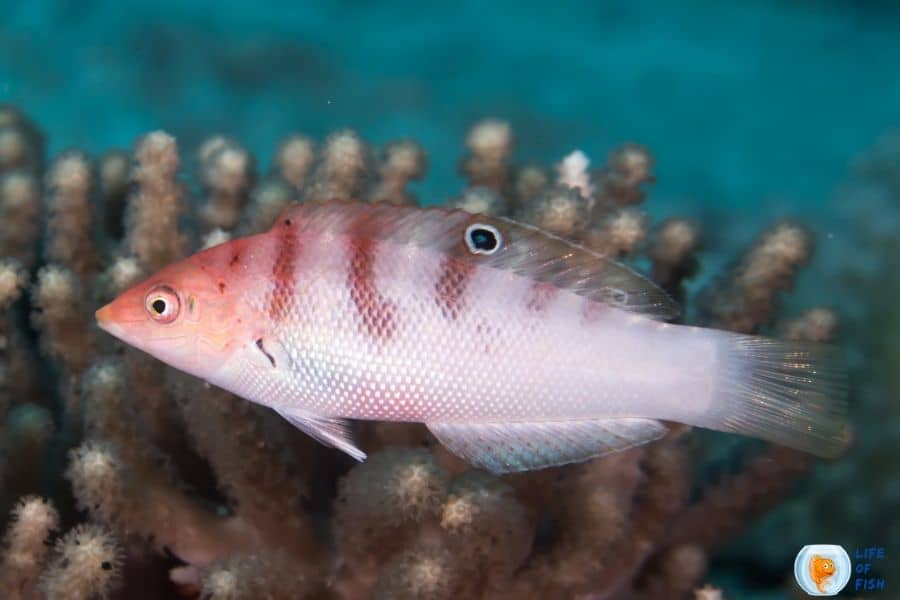
Batu coris is not a colorful wrasse like other coris wrasse species but, they are available in the aquarium trade. Native to the East African, Great barrier reef, and Tonga waters, these fish colors differ according to their area.
When they live on a dark substrate, they have a greenish body with pink markings. On a white substrate, the color becomes pale, and the markings disappear. A small-sized wrasse that grows up to 6.5 inches long, Batu coris is an omnivore fish, unlike many other carnivore wrasse species. Therefore, feeding them in captivity is not an issue for this fish.
Queen coris/ sand wrasse/ Formosan coris/ Formosa wrasse/ Indian Ocean wrasse (Coris formosa)
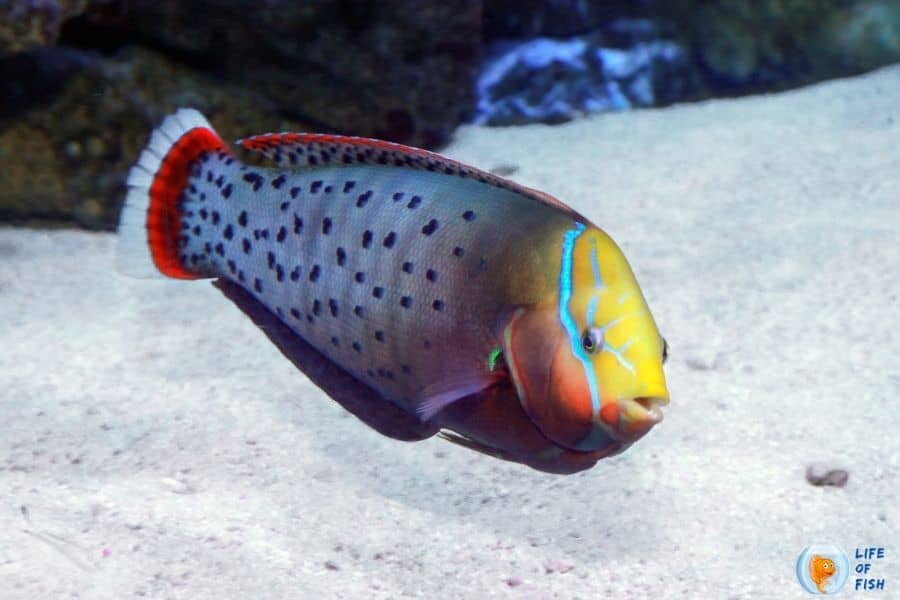
One of the most beautiful coris wrasse species, Queen coris, is a fish native to the Red Sea, East Africa, and Sri Lanka. They are fascinating and popular in the aquarium trade because their color, behavior, and diet change from juvenile to adult form.
Juvenile fish resembles clownfish, with an orange body and long white spots on the dorsal part of the body. The bottom is brownish, but these colors change when they reach maturity. Adult queen wrasse can have three different color patterns.
The most common patterns are reddish to lavender color with vibrant blue-green spots and markings on the body. They can also be blue-greenish with dark blue spots and markings and a red-orange line on the back of their body.
These fish are very dominant, territorial, and aggressive. So, care must be taken while choosing tankmates. They cannot be kept with their own kind, and sometimes also may not get along with other fish in the aquarium.
Red coris wrasse/ Yellowtail wrasse/ African coris (Coris gaimard)
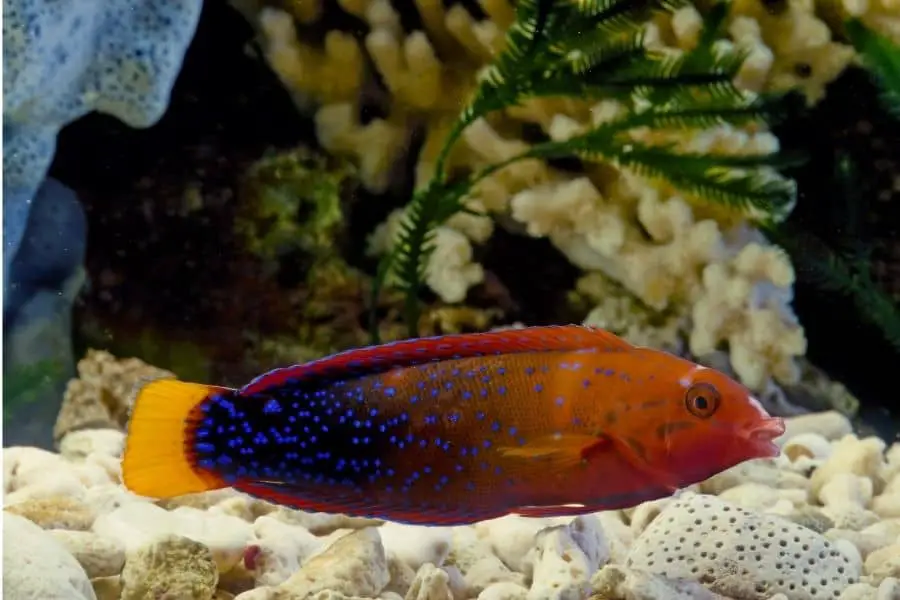
Another beautiful coris wrasse species native to the Indian Ocean and western Pacific ocean, African wrasse, is a medium-sized fish that inhabits coral reefs in the wild. These fish are also available in the aquarium trade because of their beautiful color pattern.
Amongst all the fish species I listed here, red coris wrasse is also known as “the most popular aquarium wrasse fish.” If you see the fish in the aquariums, the first thing that catches your eye is their yellow tail fin. This wrasse has a unique color pattern with three different colors on the body.
Brownish-yellow, green and blue in combination forms a fascinating color. The face and fins are pinkish brown, and they have vibrant yellowtail. The juveniles are bright red with black-margined white spots.
African wrasse is usually peaceful fish and can be kept with other peaceful fish in the aquarium. They mostly grow up to 8 inches and need a large tank. However, some specimens can reach 16 inches mark.
Comb wrasse/ combfish (Coris picta)
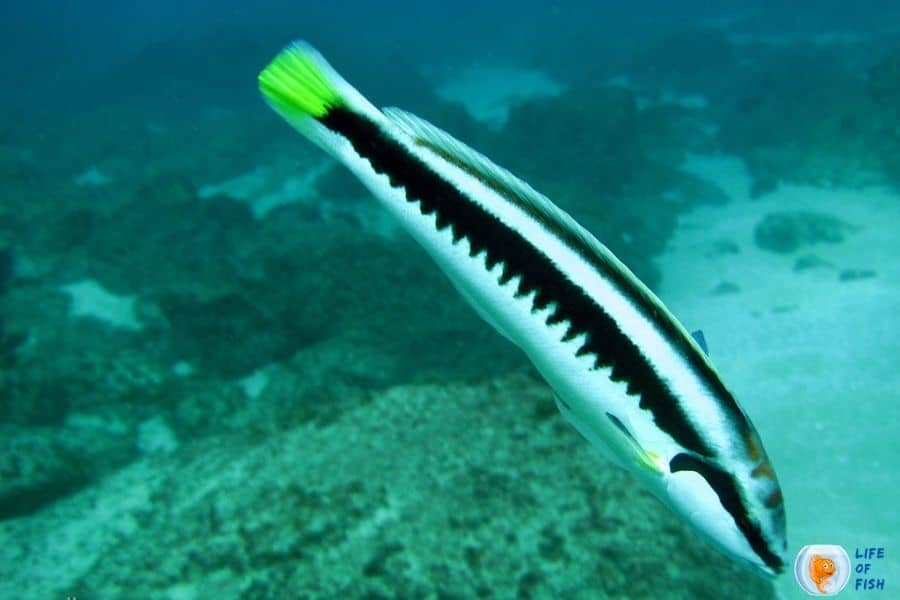
Named after their comb-like pattern on the body, comb wrasse is a species native to the Western Pacific Ocean from Australia to New Zealand. These fish inhabits rocky reefs near sandy substrates in the wild. These fish are also available in the aquarium trade as pet fish.
The combfish has a long, white body with a broad black stripe that runs from the tip of its mouth to the end of its tail. The common name “comb-tooth” is derived from the fish’s comb-like lower margin of the stripe. These fish have two rows of teeth on both jaws.
Their fins are yellowish with orange accents and green lines that form a V-shape along their midlines. Juveniles have a black tail with three blue-white bars and a white margin on the fins. They also have a black caudal spot on the tail.
Comb wrasse is a peaceful fish and good for reef aquariums. They grow up to 10 inches long and need a tank to accommodate their size. They are non-aggressive and active fish that need to be kept in groups.
African wrasse/ African coris/ false clowwrasse (Coris cuvieri)
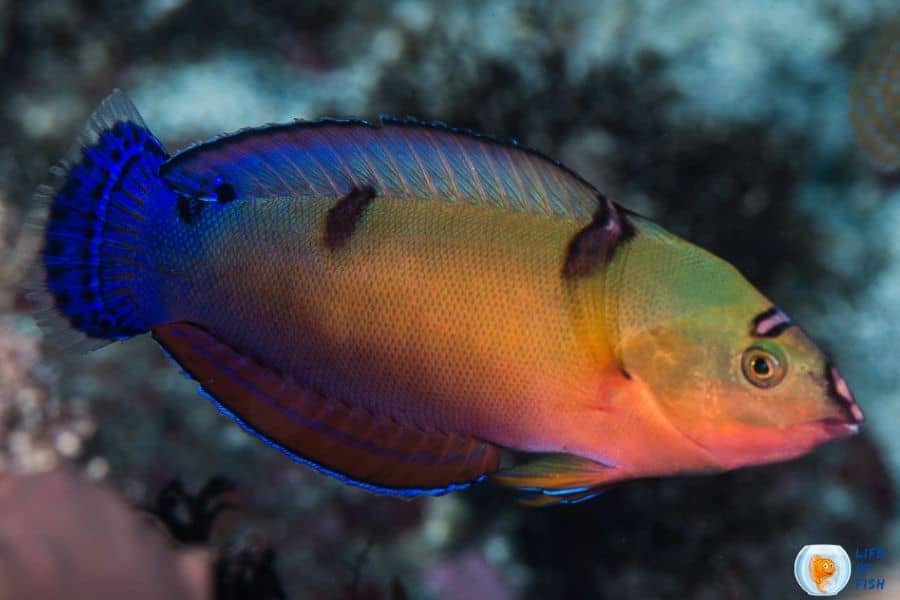
False clowwrasse is a fish found in the Indian Ocean and the Red sea. These fish are not popular like Red coris wrasse but are sometimes seen in the Aquarium trade.
False clowwrasse is a slightly larger fish that reaches 15 inches maximum with a unique colored body. Although it has duller color, it still is more beautiful than most other fish species. It has an orange-brownish body with green markings and a greenish-white verticle stripe in the middle of the body.
The male specimen has yellow and blue markings on the face, but the female lacks those markings. Juveniles are orange-red with five white patches on the body. Red coris wrasse and fake clowwrasse juveniles have a similar appearance. So, most aquarists get confused and buy these fish thinking it’s a red coris wrasse.
Mediterranean rainbow wrasse (Coris julis)
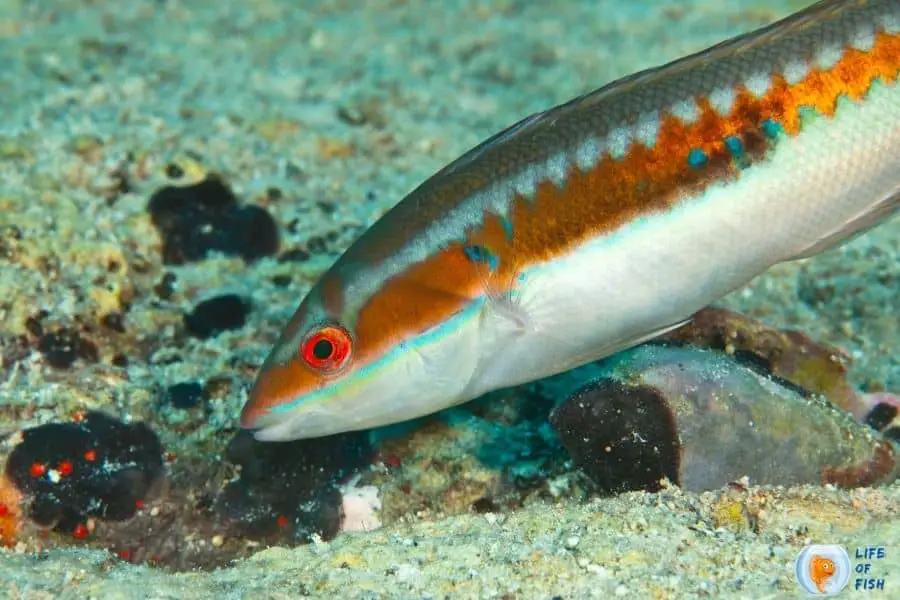
A small but colorful fish species, Mediterranean rainbow wrasse, is native to the Mediterranean sea. These fish are available in the aquarium trade and can be kept in home aquaria with proper care.
The mediterranean rainbow wrasse has two different color phases; they are blue or orange. This difference is not due to age or sex, unlike most other wrasses. The juvenile specimens have a more bluish color than when they mature. They have greenish-yellow stripes on the body with blue color. They also have three rows of teeth in their upper jaw.
Juveniles are brightly colored but turn greenish-brown when they grow up and lose most of their coloration except for dark blotches along the body. Mediterranean rainbow wrasse usually lives alone in the wild, and in the home aquaria, they need a spacious tank to accommodate their adult size.
Sandager’s wrasse (Coris sandeyeri)
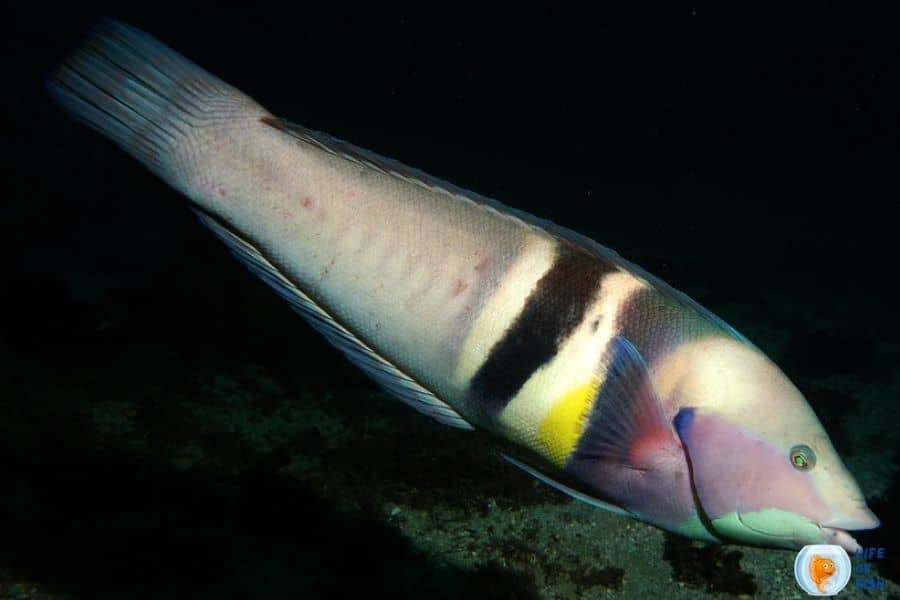
Sandager’s wrasse is a fish native to the southwestern pacific ocean and inhabits coral reefs at the depths of about 200 feet. This fish is also find in the aquarium trade.
These fish have a greyish body, with males being more vivid than females. The males have two broad black bars behind the head bordered by white and yellow. The females and juveniles lack these black bars and have a long, white snout and a stiff, erect mane.
Sandager’s wrasse prefers to stay around crevices and caves and doesn’t usually swim in open spaces. They need to keep in a group of five or more specimens in the home aquarium.
Goldlined Wrasse/ Yellow-lined Coris/ Goldlined Coris/ Yellow-lined Rainbow-wrasse (Coris aurilineata)
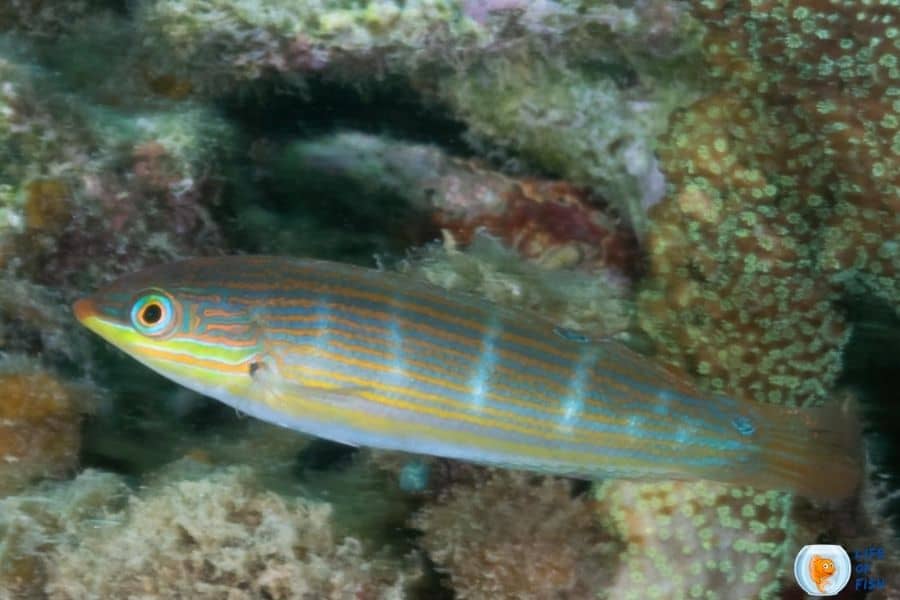
Goldlined wrasse is a fish endemic to Eastern Australia. Although these fish have a unique look, they are hard to find in the aquarium trade.
The body of this fish has thin, yellow, and blue-green stripes. Above the midline, they are considerably more distinct and vivid.
They have a blueish-grey stripe that starts from the corner of the mouth and crosses both eyes. They also have two white stripes that go vertically through the eyes. The upper half of the body has distinct yellow-gold lines on it hence their name Goldlined wrasse.
These fish grows up to 6 inches long. They can live within the coral reefs at the depths of 3 to 10 meters.
Spottail coris (Coris caudimacula)
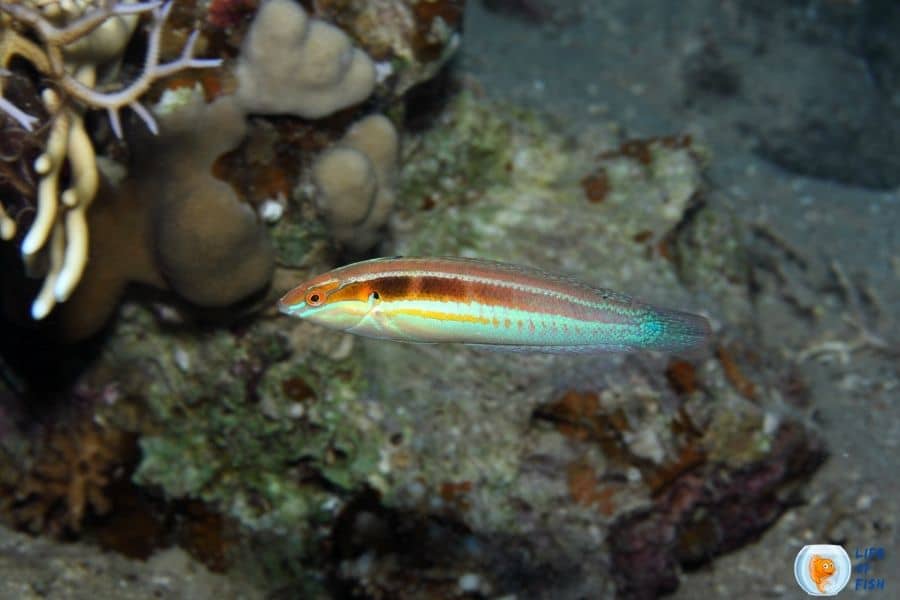
Spot tail coris is a medium-sized wrasse that grows up to 9 inches long. Although they have an attractive appearance and hardy nature, they are not common in the home aquaria. However, they can be seen in commercial aquariums.
These fish inhabits Indian and Pacific oceans, including the red sea, Australia, Japan, Indonesia, and New Zealand.
They live in lagoons and protected reefs. Spottail coris prefers to swim at the bottom of the reef rather than swimming in open water. Spottail fish often have a much different appearance than other types of wrasses. They usually possess multiple vertical bars on their body.
The opercular flap has black stripes with yellow edging at its end; these same colors can also be seen in patches throughout various body parts–from the head down through the tail tip!
And last but certainly not least: there stands out a large dark spot at the base of the tail.
They are hardy fish that can adapt well to the aquarium settings but need much larger space to accommodate, hence not popular in the home aquarium trade. Most aquarists think of these fish as small fish in the juvenile age, buy them and end up discarding or selling off their fish once they outgrow their home aquarium.
Yellowstripe coris (Coris flavovittata)

Yellowstripe coris is also a stunning coris species found in the Hawaiian islands and the Midway Islands. Although their name is Yellowstripe coris, their stripes are not yellow but are brownish-yellow.
These fish features three horizontal brownish-yellow stripes on each side with a lunar-shaped spot on the caudal fin. The body is white to ash color, and they grow up to 20 inches long, making them unsuitable for home aquariums.
If kept in an aquarium, they require a deep sandy substrate with plenty of space for swimming. They also require a varied diet to maintain their color.
These coris species were caught for the aquarium trade because of their beauty and hardiness. As with most other types of wrasses sold in the trade, aquarists should only acquire these fish after careful observation. They may not be suitable for hobbyists due to their large size, even though they are hardy fish. However, they are common in commercial aquariums.
Elegant coris (Coris Venusta)
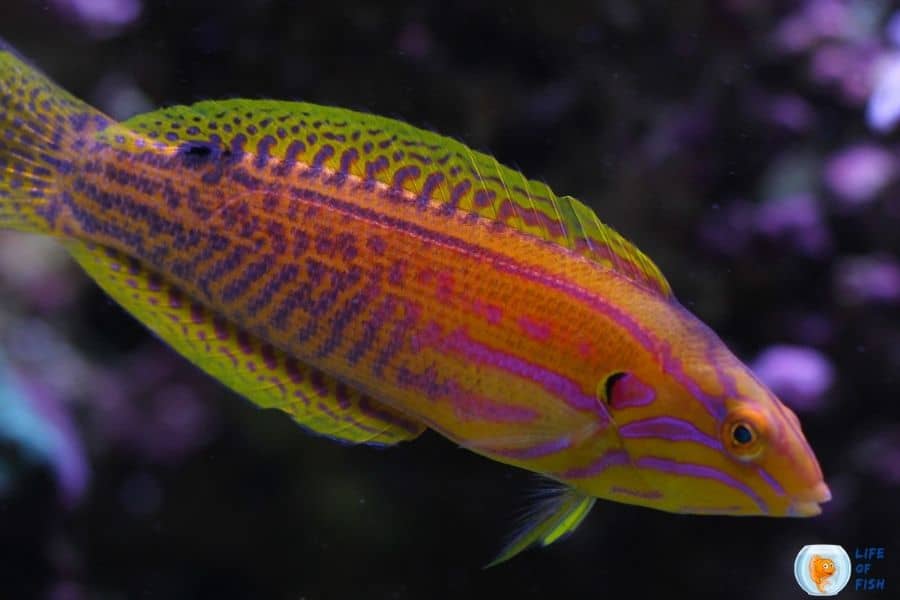
A truly elegant-looking fish, elegant coris is a small wrasse that usually grows up to 7 inches long. Elegant coris wrasses come in various color morphs, which each one is stunning.
Although they are on the market, they are not often available for sale.
These fish inhabit rocky reefs and shallow waters in the tropical waters of the Hawaiian Islands. They are sometimes kept in home aquariums, but it’s not common due to their large requirements. They will adapt well to aquarium settings if you have a large enough tank. The best way of care is to maintain them in reef aquariums.
These fish are not so common in the home aquarium trade, maybe because it is hard to distinguish them in their juvenile stage. Neither juvenile nor adults look the same. Each specimen has different colors and patterns on the body.
Juveniles are often drab in color and can be easily confused for other types of wrasses, but as the fish matures, it will take on its recognizable coloring and pattern.
Other aquarium inhabitants that are known as “Coris wrasses.”
Yellow Wrasse/ Golden Wrasse/ Golden Rainbowfish/ Yellow Coris/ Canary Wrasse (Halichoeres chrysus)
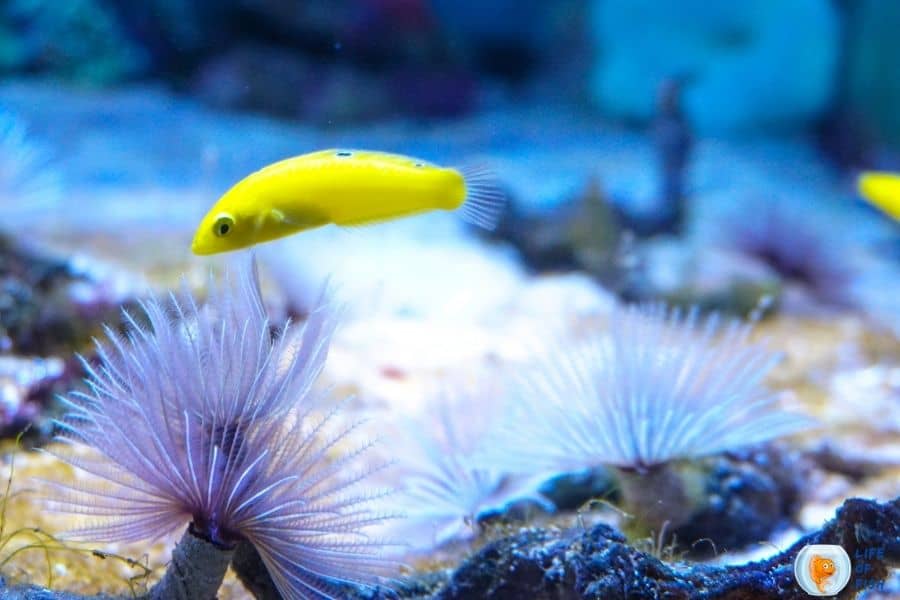
They are one of the most popular aquarium fish because of its vibrant golden color and hardiness, making them suitable for even beginners. Yellow wrasse is one of the hardiest fish species in the saltwater aquarium, and it can adapt to a wide range of water parameters.
They are popular for their bright gold coloration and an iridescent blue stripe on the lower part of the body.
These fish are also known as Golden Rainbowfish, and their common name, Yellow Coris, is a misnomer because they are not a coris wrasse species.
Yellow wrasse is a peaceful fish that can be kept with other fishes in the community aquarium. They are hardy and tolerate brackish water. However, they need to be acclimatized slowly to the brackish water. Yellow wrasse grows up to 5 inches in length but needs a large aquarium of about 50 gallons minimum as they are active swimmers and eat a lot.
Green Wrasse/ Pastel Green Wrasse/ Green Coris (Halichoeres chloropterus)
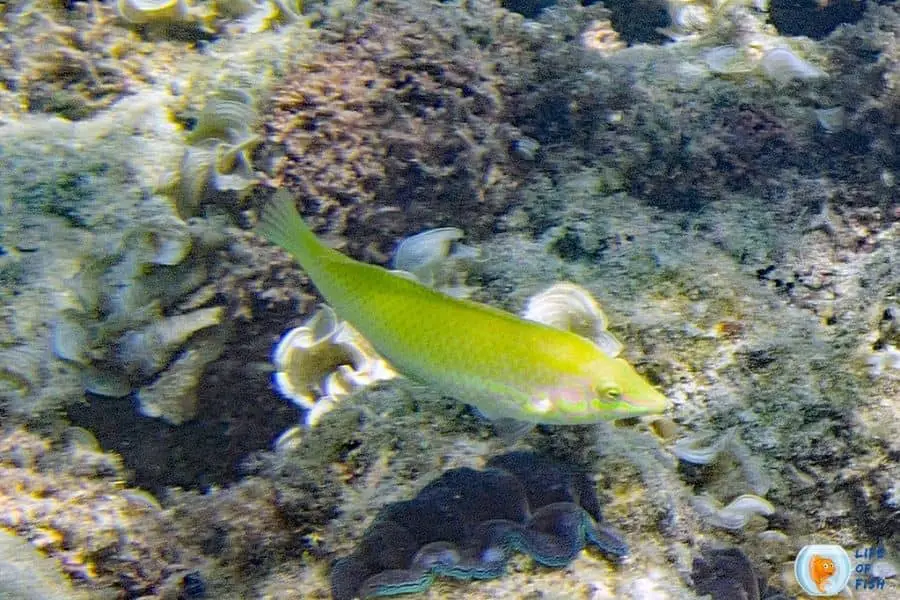
Green wrasse features a pastel green coloration with a yellow head. They are trendy in the aquarium trade, perhaps because their bright color contrasts well in the home aquarium.
These fish are hardy and relatively easy to keep as long as the water quality is maintained.
Their striking yellow head is also very attractive. Both males and female green wrasses are similar in appearance, but the male is larger. These fish are peaceful and suitable for the community aquarium with larger fish. The green wrasse can grow up to 8 inches and requires at least a 75-gallon tank to accommodate their adult size.
Conclusion
Coris wrasses are incredibly beautiful and popular for their lovely appearances. However, these saltwater fish are not commonly available in pet stores as they require large tanks and a lot of care. Although they are so beautiful, they are not ideal for home aquariums.
They will adapt well to aquarium settings if you have a large enough tank. The best way of care is to maintain them in reef aquariums. However, only some coris wrasse species are available to buy. But, fortunately, they are the most beautiful ones.
Read Next : Sailfin Fairy Wrasse ( Are They Really Worth The Money? ) Moon Wrasse or Lunare Wrasse ( A Beautiful And Magical Fish )
